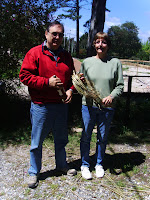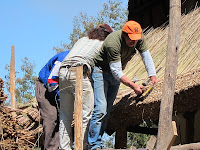Here a Quincho is usually a thatched BBQ area or a small pool house located in the back yard, however quinchado means thatched. Some main houses still have thatched roofs, here in Uruguay.
The idea of buying your main dwelling with a roof of straw (techo de paja) maybe daunting. The thought usually divides people into 2 camps. Some people will be deterred by the maintenance issues while other people will find these structures individually charming.
 One such couple who appreciates the character and charm of a quincho home is Wayne and Janet.
One such couple who appreciates the character and charm of a quincho home is Wayne and Janet.By way of introduction, you may recall a visit by Wayne and Janet to my house (not a quincho) back in January 31st, of this year (2011). The second half of that blog post was about them. They had come to Uruguay on a scouting trip to see if this was a country they would like to retire to, I guess the answer was a resounding Yes! They came back and bought a quincho home.
The advantage of a quincho house is its insulating factor. It keeps you cosy in winter and cool in the summer. Its high roof pitch makes for a lot of room inside the house
and many quincho s are two story dwellings.
I recently had the privilege of seeing their roof re-thatched in this traditional style and building technique, here in Uruguay.
Both their main house and their BBQ/parilla area are thatched and upon moving into their "new home" it was time to have it redone. You can tell when the roof needs replacing when the horizontal "fixings" or wire ties are exposed all over the roof or if gullies are appearing (vertical deep patches of rot).
Here on the back of their house you can see the horizontal steel rod lines or "fixings", showing across the entire roof. So, it was time to reroof!
Traditionally these roofs have been made out of one of three material types. Each has a different life span. #1 Long straw can last from 5-20 years. #2 Combed wheat reed, 20-30 years. #3 Water reed, 30 plus years.
The ridge will last 8-15 years. It will generally need to be replaced first before the main body of the house needs a re-job. It's vulnerable to wind and weather. I have often seen the ridges covered afterwards with a cement cap.
The reeds used on Wayne and Janet's house come from the Rio Negro, the area in San Ramon.
As you can see, even within the same type of material, the life span of the roof varies. This is due to the following factors: The roof's pitch, design, location (wind and trees, etc..) the expertise of the thatcher and most importantly, timely maintenance.
Ideally the roof's pitch should be 50 degrees. This allows any rain to travel quickly down the slope along the surface from long stem to stem and off the eave (edge). The roof also over hangs the house so that gutters are not necessary.
The idea of this roof catching on fire puts people off to buying this type of home but if some simple precautions are taken then the risk is negligible. Some suggestions are to keep bon fires and leaf burning away from the house. Always keep a non crimping hose nearby, connected if possible to the water spout. Inside, have several smoke detectors and fire extinguishers throughout the house. Some people spray the roof annually with fire retardant chemicals but this easily washes off. Things like making sure the chimney is at least 5 feet above the thatch and has a spark arrester and is swept out annually is important.
It's a good idea to keep trees and overhanging branches away from the roof. The roof lasts longer when it is dry and keeping it sunny helps with this drying process.
Many people wonder about the cost of such a roof. Wayne and Janet got several estimates from reputable thatchers and the price ran from $8000 (US) to $15000 depending on the thickness and extras. This was the price to re-do both the main house and the rear barbacoa (BBQ house). The $15,000 price would result in a thatch of a diameter of 30cm a bundle. They felt that this would be overkill. They choose the 20cm thickness at a cost of $8000. They ended up having the original thatcher come and do the job. He had done the original job in 1998 (13 years ago) and had a page on the house specs already. He knew how much thatching was needed according to those original plans. The roof had not been maintained since it had first been done.
A quincho's main roof can have the thatching either, sewn, tied or screwed on.
 In a sewn roof, the upper layer is secured (fixed) to the lathing with steel wire but without the use of steel rods.
In a sewn roof, the upper layer is secured (fixed) to the lathing with steel wire but without the use of steel rods.In a tied roof, the upper layer is secured to the lathing with steel wire and steel rods.
In a screwed roof (please resist the urge to laugh right now) the upper layer is fixed with steel wire which is then in turn screwed to the lathing.
Wayne and Janet got a tied roof. The old rods were reused.
The workers arrived each morning at 7:30. Wayne and Janet were warned to be up at that time. At lunch they take a siesta (a nap) after eating. Besides the owner of the company, Señor Gervasio Donatte, there were 3 workers. Christopher, Anthony and sorry I didn't get the name of the third guy, he was on the roof at the time.


The re-thatching schedule went like this;
1) New reeds bundles arrive. 2) Scaffolding was erected at the front of the main house. 3) The old cement caps were removed. 4) The old roof was mostly removed down to the original matting. The original underlaying reed mat (like a very thick beach mat) was still like new having been protected by the thatch. That mat is what is clearly seen inside the house above the rafters. It adds a beautiful look to the inside ceilings.
To continue.
5) The new reed bundles were sorted and the broken small reeds removed.
6) A board is placed along the bottom of the roof to line up the first row.


7) A 20 cm bundle is thrown up to the roof (it is caught in mid air by the worker) and the ties that hold the bundles together (made of reed) are removed and tossed to the ground by said worker.
 8) The bundles (one at a time) are secured (fixed) from below with wire ties. They use a long pole with a hook to push the rods in. It's like watching a giant sewing needle or harpoon.
8) The bundles (one at a time) are secured (fixed) from below with wire ties. They use a long pole with a hook to push the rods in. It's like watching a giant sewing needle or harpoon.
9) gradually they work up the roof.
10) They eventually reach the top of the first side and secure the ridge. The ridge covers the last "fixing."
You can now see the worker from the other side of the house.

Using simple tools, including a comb like paddle, and some wire this process takes about a week (5 days) to work up a side. They don't work in the rain. You can still live in the house if the original matting is there because they only remove the old roof a piece at a time as they work their way up.
It will take 3 to 4 weeks to finish this project. I believe this includes the roof of the BBQ house. That new "thatch color" will last for 2 years then fade to gray like cedar wood does in furniture.
Their new thatched roof will last 15 to 20 years but it will need yearly inspections by the owner to clear off leaves etc... Also it will need to be looked after about every 5 years to help keep it at the longer life span projection. That's why it takes a special kind of person or in this case a couple who truly admire the thatched roof's charm.
To be honest, I'm one of those people who would shy away from buying a quincho. The commitment is similar to buying an historic house. You feel responsible to keep the legacy pure. I'm glad however that I got to see this traditional method of building first hand and personal. I want to thank Wayne and Janet for thinking of me. Also, I have to share photo credits with Wayne this time around. After taking some 78 photos, my camera's battery died and he helped out with a few more shots that I wanted to take. The really good photos are his!
Now, instead of thinking about only charming English cottages you can also add visions of lovely Uruguayan quincho s to your dreams. It's nice to know that there are immigrants to this country, foreigners like Wayne and Janet who value and want to help keep this Uruguayan tradition alive.






























